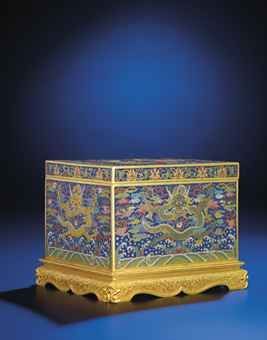An Important Imperial Cloisonne Enamel Inkstone Warmer And Cover. Qianlong Cast Six-Character Mark And Of The Period (1736-1795)
An Important Imperial Cloisonne Enamel Inkstone Warmer And Cover. Qianlong Cast Six-Character Mark And Of The Period (1736-1795). Photo Christie's Image Ltd 2012
The rectangular cover is elaborately decorated with a writhing front-facing five-clawed dragon picked out in vivid yellow, pursuing a 'flaming pearl' amidst multi-coloured ruyi clouds against a bright sapphire-blue ground, above rolling waves and a terrestrial diagram from which issues various beribboned auspicious symbols, all within a gilt border. This pattern is similarly repeated on the four sides of the rectangular box, with the two dragons on the longer sides picked out in tones of an attractive sea-green. It is connected to a beaded pedestal supported on a gilt stand with bracket-shaped aprons, delicately decorated with floral scrolls. The base is gilt and cast with a Qianlong six-character mark within a rectangular panel, encircled by two coiling five-clawed dragons contesting a 'flaming pearl' in high relief. 6 3/16in. (15.9 cm.) high, 8 1/4 in. (21.1 cm.) long, 6 3/8 in. (17.1 cm.) wide, Japanese wood box. Estimate HK$4,000,000 - HK$6,000,000 ($518,530 - $777,796)
Provenance: A prominent Japanese collection, acquired in the late 19th century
Notes: The current box would have originally contained a shallow tray to hold ink stones. Hot water or ashes of hot coal would have been placed within the box below the tray in order to keep the ink stones warm, preventing the ink from freezing during the cold winters.
Palace records show that this box was made for the Qianlong Emperor by the enamel workshop atZaobanchu in the Hall of Mental Cultivation. One entry in the records in particular recounts the entire manufacturing process of this box from initial design to final approval by the Emperor. It records that in the 39th year and 12th month of the Qianlong reign (corresponding to 1774), the enamel workshop first presented a sample of an inkstone warmer to the Qianlong Emperor. Throughout the next two months the Emperor issued several orders for the adjustment of size of the box and that the box should be made in cloisonné enamel. He also made specific instructions for the four sides of the box to be decorated with front-facing dragons instead of leaping dragons, and the four sides of the cover to be decorated with Indian lotus scrolls, as in the case of the current box. From this detailed record the current box was undoubtedly made in accordance to the wish of the Qianlong Emperor.
 There are identical examples in the Palace Museum, Beijing and the National Palace Museum, Taipei, although both of these have their original shallow trays holding the ink stones. The warmer belongs to an original set of cloisonné enamel stationery comprising the brush rack, water receptacle and ink stand. The Beijing example is illustrated in Gold, Silver, Glass, Enamels, Zhongguo meishu quanji, vol. 10, Beijing, 1987, pl.333; and Enamels 3: Cloisonne in the Qing Dynasty (1644-1911), Compendium of Collections in the Palace Museum, Beijing, 2011, pl. 48 (illustrated right). The Taipei example, together with the complete set of stationery, are illustrated in Enamel Ware in the Ming and Ch'ing Dynasties, Taipei, 1999, pl. 53.
There are identical examples in the Palace Museum, Beijing and the National Palace Museum, Taipei, although both of these have their original shallow trays holding the ink stones. The warmer belongs to an original set of cloisonné enamel stationery comprising the brush rack, water receptacle and ink stand. The Beijing example is illustrated in Gold, Silver, Glass, Enamels, Zhongguo meishu quanji, vol. 10, Beijing, 1987, pl.333; and Enamels 3: Cloisonne in the Qing Dynasty (1644-1911), Compendium of Collections in the Palace Museum, Beijing, 2011, pl. 48 (illustrated right). The Taipei example, together with the complete set of stationery, are illustrated in Enamel Ware in the Ming and Ch'ing Dynasties, Taipei, 1999, pl. 53.
Compare also to a Qianlong-marked cloisonné enamel fangding formerly in the Mandel Collection, sold at Christie's Hong Kong, 30 May 2012, lot 3908. The cover of the Mandel censer is decorated with four front-facing dragons amidst dense ruyi clouds above cresting waves issuing auspicious treasures, in a similar style as the dragons on the current warmer.
Christie's. Important Chinese Ceramics and Works of Art. 28 November 2012. Hong Kong

/https%3A%2F%2Fprofilepics.canalblog.com%2Fprofilepics%2F1%2F0%2F100183.jpg)
/https%3A%2F%2Fstorage.canalblog.com%2F03%2F02%2F119589%2F96711876_o.jpg)
/https%3A%2F%2Fstorage.canalblog.com%2F11%2F31%2F119589%2F94773502_o.jpg)
/https%3A%2F%2Fstorage.canalblog.com%2F20%2F83%2F119589%2F94772815_o.jpg)
/https%3A%2F%2Fstorage.canalblog.com%2F26%2F72%2F119589%2F75604929_o.jpg)
/https%3A%2F%2Fstorage.canalblog.com%2F59%2F60%2F119589%2F26458628_o.jpg)





/http%3A%2F%2Fstorage.canalblog.com%2F49%2F06%2F119589%2F110810104_o.jpg)
/http%3A%2F%2Fstorage.canalblog.com%2F53%2F79%2F119589%2F110809895_o.jpg)
/http%3A%2F%2Fstorage.canalblog.com%2F27%2F20%2F119589%2F96711168_o.jpg)
/http%3A%2F%2Fstorage.canalblog.com%2F65%2F65%2F119589%2F96710891_o.jpg)